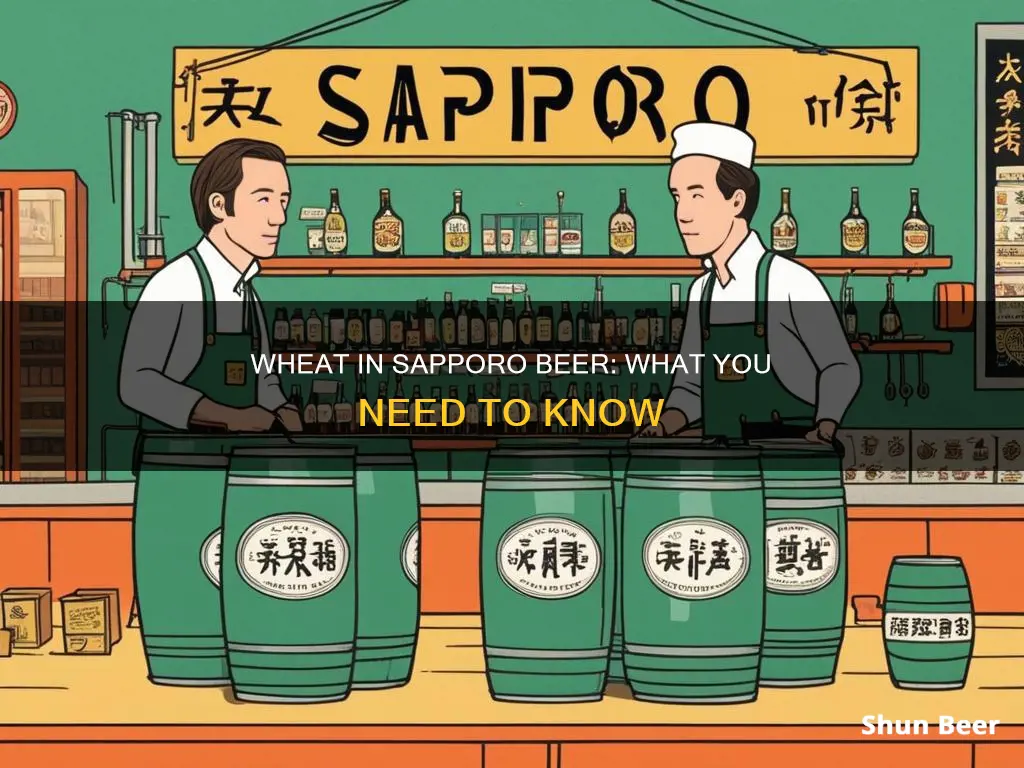
Sapporo is a Japanese beer that has become one of the most popular beers in the US. It is a rice beer, but it also contains barley, water, yeast, and hops. This means that Sapporo is not gluten-free and is unsuitable for people with celiac disease or gluten intolerance.
| Characteristics | Values |
|---|---|
| Gluten-free | No |
| Ingredients | Water, barley and/or barley malt, rice, yeast and hops |
| Nutritional facts per 12oz serving | 4.9% ABV, 140 Calories, 10.3 grams Carbohydrates, 0.0 grams Fat |
What You'll Learn

Sapporo is not gluten-free
Sapporo Beer is not gluten-free and is made with barley, which contains gluten. The beer also contains malt, yeast, hops, and water. The presence of barley and malt means that Sapporo is not gluten-free and is not recommended for people with celiac disease or gluten intolerance.
Sapporo Beer has a gluten content of more than 20 parts per million (ppm), which is above the recommended limit for gluten-free products. According to the FDA, a product must contain less than 20 ppm gluten to be labelled as gluten-free. Therefore, Sapporo cannot be considered gluten-free.
People with celiac disease or gluten intolerance should avoid Sapporo Beer due to its gluten content. There are, however, several gluten-free beer alternatives available on the market that use rice, millet, sorghum, soy, or peas protein instead of wheat, malt, or barley. These gluten-free options provide a similar flavor to Sapporo, while being safe for those with gluten sensitivities.
While Sapporo is not gluten-free, it has a crisp, refined flavor and a clean finish, making it a popular choice for those who can consume gluten. It is the oldest beer brand in Japan and has been available in the United States since 1964. The beer is currently produced in Canada, the United States, and Vietnam.
Beer and Wheat: What's the Connection?
You may want to see also

Sapporo's ingredients
Sapporo Premium Beer is a refreshing lager with a crisp, refined flavour and a clean finish. It is made with water, barley and/or barley malt, rice, yeast and hops. The barley and malt in the beer mean it is not gluten-free and it is not recommended for people with celiac disease.
Sapporo Premium has a bold and stronger taste made from premium barley and hops. Its somewhat sweet bitter taste makes it the best drink to pair with spicy dishes. The ingredients include nutritional facts of alcohol by volume (ABV), calories, carbohydrates and fat.
Sapporo Premium Light has a refined, smooth taste with a low-calorie count. It has the same ingredients as the original premium beer, but with less alcohol content.
Sapporo Reserve Beer has a more intense and complex taste. It is an all-malt beer with a supple texture and great intensity. It is best served cold or chilled to avoid an intense bitter taste.
Sapporo is Japan's oldest beer brand, first brewed in 1876 by Seibei Nakagawa, who brought his knowledge of brewing back from Germany. It is now brewed in four regions in Japan (Chiba, Sendai, Shizuoka, and Kyushu) and also in Canada and Vietnam.
Wheat in Beer: Amberbock's Secret Ingredient?
You may want to see also

Sapporo's nutritional facts
Sapporo Beer is made from barley, malt, yeast, hops, and rice. It is not gluten-free and has more than 20ppm of gluten, which is beyond the recommended limit for it to be gluten-free. Therefore, it is not suitable for people with celiac disease or a high level of gluten intolerance.
A 12oz serving of Sapporo Premium Beer contains 140 calories, 10.3 grams of carbohydrates, and 0 grams of fat. The alcohol by volume (ABV) is 4.9%. The calorie breakdown is 0% fat, 88% carbs, and 12% protein.
Sapporo Premium Black has a bold and stronger taste made from premium barley and hops. Its slightly sweet bitter taste makes it a good drink to pair with spicy dishes. The nutritional facts for this variety include alcohol by volume (ABV).
Sapporo Premium Light has a refined, smooth taste with a low-calorie count. It has the same ingredients as the original premium variety but with a lower alcohol content. The nutritional facts for this variety include alcohol by volume (ABV).
Sapporo Reserve Beer has a more intense and complex taste. It is an all-malt beer with a supple texture and great intensity. It is best served cold or chilled to avoid the intense bitter taste. The nutritional facts for this variety include alcohol by volume (ABV).
Lagers and Wheat Beers: What's the Difference?
You may want to see also

Gluten-free alternatives to Sapporo
Sapporo is a Japanese beer that contains barley, and therefore gluten. As a result, it is not gluten-free and is not recommended for people with celiac disease. However, there are several gluten-free alternatives to Sapporo beer that use rice, millet, sorghum, soy, or peas protein instead of wheat, malt, or barley. Here are some options:
Buck Wild Pale Ale by Alpenglow Beer Company
Born out of a passion for crafting 100% gluten-free beers that taste exactly like beer, Buck Wild is a gluten-free alternative for those with celiac disease or gluten intolerance.
Redbridge Lager by Anheuser-Busch
Anheuser-Busch has created a fine, hand-crafted specialty beer without wheat or barley, ensuring that adults with severe wheat allergies or gluten intolerance can enjoy this beer without worry.
Felix Pilsner by Bierly Brewing
Bierly Brewing uses gluten-free grains like millet, rice, buckwheat, and sorghum to create their beers. In addition, other ingredients such as yeast, honey, spices, and hops are also gluten-free.
Gluten-Free Pale Ale by Wild Polly Brewing Co.
Wild Polly Brewing Co. offers distinctive, full-flavored, ancient grain beers for those seeking untapped, wild brews.
Celia Saison by Ipswich Ale Brewery
A sorghum-based beer inspired by the ales of Belgium, Celia Saison has a rustic farmhouse style.
New Grist by [unknown brewery]
New Grist is another gluten-free beer option, made from sorghum, hops, rice, and gluten-free yeast.
While these gluten-free alternatives may differ slightly in texture and taste from Sapporo due to the variation in grains, they provide safe and enjoyable options for those who need to avoid gluten.
Lager Beer and Wheat: What's the Connection?
You may want to see also

Sapporo's history
Sapporo is a Japanese beer brewing company that has been producing top-selling beers since 1876. It is the oldest beer brand in Japan and was founded by Seibei Nakagawa, Japan's first German-trained brewmaster. At the age of 17, he left Japan for Germany, where he learned the craft of brewing. He brought this knowledge back to Japan and became Sapporo's first brewmaster.
The first Sapporo beer was brewed in Sapporo, Hokkaido, Japan, in 1876. The company has since expanded and now has five breweries in Japan, as well as breweries in the US, Canada, and Vietnam. The main brands are Sapporo Draft, Yebisu, and Sleeman Cream Ale.
Sapporo first made its way to America in 1964, and in 1984, Sapporo U.S.A., Inc. was founded. Today, Sapporo is the #1 selling Asian Beer in the United States. The company has a strong commitment to quality and has invested in upgrading its brewing facilities to ensure the highest standards.
Sapporo has a rich history and has played a significant role in the development of the beer industry in Japan. The company has gone through various mergers and acquisitions over the years, including the formation of the Dai-Nippon Beer Company, Ltd. in 1906, which created a near monopoly on the Japanese market until after World War II. After the war, the company underwent several changes, and in 1956, the Nippon Breweries resumed production of Sapporo beer. The company was renamed Sapporo Breweries in 1964, and it has since continued to expand and innovate, winning awards for its beers and packaging.
Is Pacifico Beer Wheat-Based?
You may want to see also
Frequently asked questions
No, Sapporo beer does not contain wheat. Its ingredients include water, barley and/or barley malt, rice, yeast, and hops.
Sapporo beer is made from barley, malt, yeast, and rice. It is a rice beer.
No, Sapporo is not gluten-free. It contains gluten and should be avoided by those with gluten sensitivity or celiac disease.







